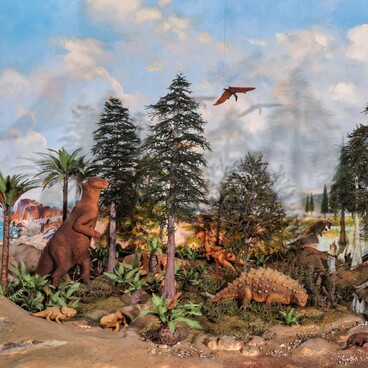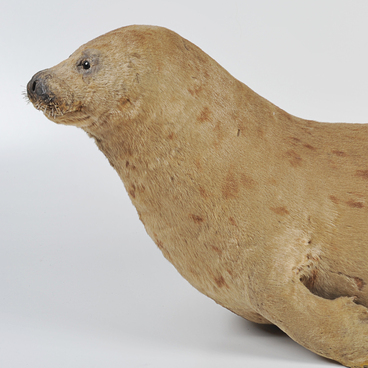In the hall of the State Biology Museum, dedicated to plants, part of the extensive collection of cones is presented. In total, it includes more than 300 samples collected in Russia and abroad.
A cone is a modified shortened shoot, by which the plant reproduces. They are characteristic of representatives of the Pinophyta class from gymnosperms — an ancient group of plants that appeared at the end of the Carboniferous period, about 319 million years ago.
Many of the cones are cone-shaped. A distinction is made between male and female cones: microstrobils and megastrobils. In pollen cones, pollen is formed, which is carried by the wind. On the upper side of the seed cones, there are two ovules. They lie openly and are not protected by anything–from this the name ‘gymnosperms’ (revealed seeds) originated. From these ovules, seeds develop after pollination. When they ripen, the seed cones open, and the seeds are either carried by the wind or eaten by animals.
The most interesting samples of the presented collection are the cones of Roxburgh pine, frankincense pine and Himalayan cedar.
The Roxburgh’s pine, or Indian long pine, grows in the Himalayas in areas with a monsoon climate. It is an evergreen tree up to 50 meters high with thick red-brown bark and yellowish-green needles, which are about 35 centimeters long. Its male pollen cones are arranged spirally at the base of the young shoots. Female seed cones usually grow singly, but on strong branches they grow in whorls, or nodes, of 2–5. Roxburgh pine cones take two years to mature, opening slowly in the second year, releasing winged seeds. They are dispersed by the wind.
The frankincense pine is native to the southeastern United States along the Atlantic coast. This evergreen tree, about 35 meters high, grows in lowlands, in river valleys, on damp and boggy grounds. The pine has thin light green needles up to 22 centimeters long, it is located in bunches of five pieces and stays on the branches for two years. Mature seed cones are light buff-brown.
Himalayan cedar grows in East Asia. It is found in the mountains up to an altitude of 3,600 meters and lives for about a thousand years, and in some cases up to three thousand years. This large evergreen tree grows up to 50 meters high and 3 meters in diameter. Its soft gray-green needles gather in dense bunches on short shoots. The pollen in microsporangiate cones ripens in the fall. Megasporangiate cones are on the branches and directed upwards. When they ripen and decay, they release small winged seeds that contain a lot of pitch and are practically not edible.
A cone is a modified shortened shoot, by which the plant reproduces. They are characteristic of representatives of the Pinophyta class from gymnosperms — an ancient group of plants that appeared at the end of the Carboniferous period, about 319 million years ago.
Many of the cones are cone-shaped. A distinction is made between male and female cones: microstrobils and megastrobils. In pollen cones, pollen is formed, which is carried by the wind. On the upper side of the seed cones, there are two ovules. They lie openly and are not protected by anything–from this the name ‘gymnosperms’ (revealed seeds) originated. From these ovules, seeds develop after pollination. When they ripen, the seed cones open, and the seeds are either carried by the wind or eaten by animals.
The most interesting samples of the presented collection are the cones of Roxburgh pine, frankincense pine and Himalayan cedar.
The Roxburgh’s pine, or Indian long pine, grows in the Himalayas in areas with a monsoon climate. It is an evergreen tree up to 50 meters high with thick red-brown bark and yellowish-green needles, which are about 35 centimeters long. Its male pollen cones are arranged spirally at the base of the young shoots. Female seed cones usually grow singly, but on strong branches they grow in whorls, or nodes, of 2–5. Roxburgh pine cones take two years to mature, opening slowly in the second year, releasing winged seeds. They are dispersed by the wind.
The frankincense pine is native to the southeastern United States along the Atlantic coast. This evergreen tree, about 35 meters high, grows in lowlands, in river valleys, on damp and boggy grounds. The pine has thin light green needles up to 22 centimeters long, it is located in bunches of five pieces and stays on the branches for two years. Mature seed cones are light buff-brown.
Himalayan cedar grows in East Asia. It is found in the mountains up to an altitude of 3,600 meters and lives for about a thousand years, and in some cases up to three thousand years. This large evergreen tree grows up to 50 meters high and 3 meters in diameter. Its soft gray-green needles gather in dense bunches on short shoots. The pollen in microsporangiate cones ripens in the fall. Megasporangiate cones are on the branches and directed upwards. When they ripen and decay, they release small winged seeds that contain a lot of pitch and are practically not edible.



